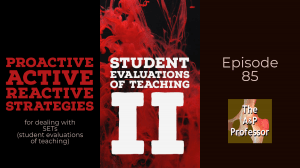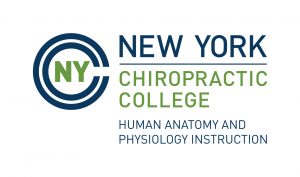Host Kevin Patton continues the discussion about student evaluations of teaching (SETs) with a set of strategies to make them work better, or at least mitigate some of the potentially bad or ugly outcomes. There are things we can do proactively before a SET, actively during a SET, and reactively after a SET. Listen to hear them all!
- 00:00 | Quotation
- 00:57 | Student Evaluation of Teaching: Part II
- 04:16 | Sponsored by AAA
- 05:39 | Proactive Strategies
- 12:49 | Sponsored by HAPI
- 14:03 | Active Strategies
- 29:52 | Sponsored by HAPS
- 31:18 | Reactive Strategies
- 46:15 | Cookies!
- 48:00 | Staying Connected
If you cannot see or activate the audio player click here.
Apply for your credential (badge/certificate) for listening to this episode.
Please take the anonymous survey: theAPprofessor.org/survey
Questions & Feedback: 1-833-LION-DEN (1-833-546-6336)
Follow The A&P Professor on Twitter, Facebook, Blogger, Nuzzel, Tumblr, or Instagram!
The best way to not feel hopeless is to get up and do something. Don’t wait for good things to happen to you. If you go out and make some good things happen, you will fill the world with hope, you will fill yourself with hope. (Barack Obama)
Student Evaluation of Teaching II
3.5 minutes
A brief intro to this second of two discussions of student evaluation of teaching. It's easier to follow this one if you've first listened to Student Evaluations of Teaching I: The Good, The Bad, and The Ugly | TAPP 84.
Sponsored by AAA
1.5 minutes
A searchable transcript for this episode, as well as the captioned audiogram of this episode, are sponsored by the American Association for Anatomy (AAA) at anatomy.org.
Don't forget—HAPS members get a deep discount on AAA membership!
Proactive Strategies for SETs
7 minutes
There's a lot we can do well in advance of student evaluations of teaching being administered. For example, speaking up and signing up to facilitate change in our own institutions.
- Mitigating gender bias in student evaluations of teaching (recent journal article) my-ap.us/3oaDXGG
- Actual Learning vs. Feeling of Learning | Journal Club Episode | TAPP 83 (mentions value of transparency)
- The Case for Transparency | Episode 51
Sponsored by HAPI Online Graduate Program
1.5 minutes
The Master of Science in Human Anatomy & Physiology Instruction—the MS-HAPI—is a graduate program for A&P teachers, especially for those who already have a graduate/professional degree. A combination of science courses (enough to qualify you to teach at the college level) and courses in contemporary instructional practice, this program helps you be your best in both on-campus and remote teaching. Kevin Patton is a faculty member in this program. Check it out!
Active Strategies for SETs
16 minutes
There are strategies we can implement as SETs are being implemented, such as promoting greater participation by students and training students on how to evaluation courses and teachers effectively.
- Dr. Amy Simolo (HAPI faculty my-ap.us/2XhAJFP) created a tool for use at NYCC that teaches students how to evaluate courses & teachers in a professional manner. Included are six key tips:
- Be respectful.
- Focus on observable behavior.
- Be constructive.
- Offer actionable solutions.
- Stay on point.
- Give constructive and specific praise.
- Kevin's briefer message to instruct students on evaluating courses & teachers:
- First, take a moment to reflect on your hard work—that desirable difficulty—resulting in the progress you've made in refreshing all those forgotten concepts and filled in the gaps for those concepts you somehow missed learning along the way. Then, will you please take a moment now to fill out the super-brief, super-easy CourseEval survey?
- Please remember to be professional, respectful, and constructive in your responses. If you do that, stay focused on just this course/instructor, note specific things that helped you, and offer actionable solutions that improve learning, then my bosses (and I) will be more likely to understand and value your opinion. And take actions that will help future students in this course.
- End-of-Term Reviews Help Keep Your Course on Track | Episode 17
- Mid-Semester Check-Ins Keep Your A&P Course on Track | Episode 38
- Krebs Cycle Horror Story | Anatomy Terms | TAPP 79 (explains that outburst when Kevin mentions the Krebs Cycle)

Sponsored by HAPS
1.5 minutes
The Human Anatomy & Physiology Society (HAPS) is a sponsor of this podcast. You can help appreciate their support by clicking the link below and checking out the many resources and benefits found there. Watch for virtual town hall meetings and upcoming regional meetings!
Reactive Strategies for SETs
15 minutes
Some things we ought to be doing after SETs are administered include doing our own surveys, debriefings, and/or reflections—and compiling, reflecting upon, and writing a statement analyzing them. This helps us in the moment, as well as if/when we're challenged by our supervisor. And there are even things we can do to mitigate potential problems with those online professor-rating sites!
- End-of-Term Reviews Help Keep Your Course on Track | Episode 17
- For quick jotting down of student comments:
- Index card wallet
- Levenger Pocket Briefcase that Kevin uses amzn.to/2Uwmitj
- Oxford At-Hand Note Card Case amzn.to/2GmixBU
- Perotti leather card wallet amzn.to/2IwXct2
- Moleskine notebooks amzn.to/2PkNsCG
- OneNote my-ap.us/2Dzy1SD
- Evernote my-ap.us/2Dq03j4
- Index card wallet
- Where Kevin sends his disappointed students:
Cookies!
2 minutes
To prove the point that SETs don't necessarily measure what we are pretending that they measure, it's been proven that supplying students with cookies produces higher scores on SETs. So if we are measuring how pampered students feel, then maybe SETs are indeed the answer!
- Kevin's Favorite Blueberry-Walnut Oatmeal Cookie Recipe my-ap.us/386hSn6
- Availability of cookies during an academic course session affects evaluation of teaching (research article from Medical Education) my-ap.us/34VVsTt
If the hyperlinks here are not active, go to TAPPradio.org to find the episode page.
- More details at the episode page.
- Transcript available in the transcript box.
- Listen to any episode on your Alexa device.
- Need help accessing resources locked behind a paywall? Check out this advice from Episode 32 to get what you need! https://youtu.be/JU_l76JGwVw?t=440
Take The A&P Professor experience to the next level!
The A&P Professor community
Earn cash by referring other A&P faculty to this podcast:
theAPprofessor.org/refer
Tools & Resources
- Amazon
- Text Expander
- Rev.com
- Snagit & Camtasia
- Krisp Free Noise-Cancelling App
- The A&P Professor Logo Items
Sponsors
- Transcript and captions for this episode are supported by the American Association for Anatomy | anatomy.org
- The Human Anatomy & Physiology Society provides marketing support for this podcast | theAPprofessor.org/haps
- Distribution of this episode is supported by NYCC's online graduate program in Human Anatomy & Physiology Instruction (HAPI) | nycc.edu/hapi
Clicking on sponsor links helps let them know you appreciate their support of this podcast!
Follow The A&P Professor on Twitter, Facebook, Blogger, Nuzzel, Tumblr, or Instagram!
The A&P Professor® and Lion Den® are registered trademarks of Lion Den Inc. (Kevin Patton)
As an Amazon Associate I earn from qualifying purchases. I may be compensated for links to sponsors and certain other links.
Click here to listen to this episode—or access the detailed notes and transcript.








No comments:
Post a Comment